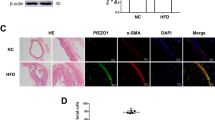Abstract
The present study was designed to investigate whether arsenic trioxide induced the apoptosis in rat mesenteric arterial smooth muscle cells (SMCs), which provides new insights into mechanisms of arsenic-related vascular diseases. Here, we found that arsenic trioxide significantly decreased the viability of SMCs in a dose-dependent manner. In addition, higher level of arsenic trioxide directly caused cellular necrosis. The Hoechst and AO/EB staining demonstrated that apoptotic morphological change was presented in SMCs exposed to arsenic trioxide. The TUNEL assay displayed that more positive apoptotic signal appeared in SMCs treated with arsenic trioxide. The following result showed that ROS formation was markedly increased in arsenic trioxide-treated SMCs. Pretreatment with N-acetylcysteine, an anti-oxidant reagent, obviously attenuated the enhancement of ROS production and the reduction of cell viability induced by arsenic trioxide in SMCs. Arsenic trioxide also enhanced free intracellular Ca2+ level in SMCs. BAPTA also significantly prevented the increased intracellular Ca2+ and decreased cell viability induced by arsenic trioxide in SMCs. These results suggested that arsenic trioxide obviously induced apoptosis in SMCs, and its mechanism was partially associated with intracellular ROS formation and free Ca2+ increasing.








Similar content being viewed by others

References
Jones FT (2007) A broad view of arsenic. Poult Sci 86:2–14
Asou N (2005) Arsenic trioxide in the treatment of relapsed and refractory acute promyelocytic leukemia. Int Med 44:775–776
Chen Y, Factor-litvak P, Howe GR et al (2007) Arsenic exposure from drinking water, dietary intakes of B vitamins and folate, and risk of high blood pressure in Bangladesh: a population-based, cross-sectional study. Am J Epidemiol 165:541–552
Rossy KM, Janusz CA, Schwartz RA (2005) Cryptic exposure to arsenic. Indian J Dematol Venereol Leprol 71:230–235
Yu G, Sun D, Zheng Y (2007) Health effects of exposure to natural arsenic in groundwater and coal in China: an overview of occurrence. Environ Health Persp 115:636–642
Chen CJ, Hsueh YM, Lai MS et al (1995) Increased prevalence of hypertension and long-term arsenic exposure. Hypertension 25:53–60
Rahman M, Tondel M, Ahmad SA et al (1999) Hypertension and arsenic exposure in Bangladesh. Hypertension 33:74–78
Lau AT, Li M, Xie R et al (2004) Opposed arsenite-induced signaling pathways promote cell proliferation or apoptosis in cultured lung cells. Carcinogenesis 25:21–28
Zhang H, Liu P, Yu XH et al (2008) Mechanism of arsenic trioxide induced apoptosis in cultured human lens epithelium cells. Zhonghua Yan Ke Za Zhi 44:916–920
Meliker JR, Wahl RL, Cameron LL et al (2007) Arsenic in drinking water and cerebrovascular disease, diabetes mellitus, and kidney disease in Michigan: a standardized mortality ratio analysis. Environ Health 6:4
Tseng CH (2008) Cardiovascular diseases in arsenic-exposed subjects living in the arseniasis-hyperendemic areas in Taiwan. Atherosclerosis 199:12–18
Wang CH, Jeng JS, Yip PK et al (2002) Biological gradient between long-term arsenic exposure and carotid atherosclerosis. Circulation 105:1804–1809
Blaschke F, Bruemmer D, Yin F et al (2004) C-reactive protein induces apoptosis in human coronary vascular smooth muscle cells. Circulation 110:579–587
Su J, Li J, Li W et al (2004) Cocaine induces apoptosis in primary cultured rat aortic vascular smooth muscle cells: possible relationship to aortic dissection, atherosclerosis, and hypertension. Int J Toxicol 23:233–237
Zhang S, Fantozzi I, Tigno DD et al (2003) Bone morphogenetic proteins induce apoptosis in human pulmonary vascular smooth muscle cells. Am J Physiol, Lung C 285:L740–L754
Woo SH, Park MJ, An S et al (2005) Diarsenic and tetraarsenic oxide inhibit cell cycle progression and bFGF- and VEGF-induced proliferation of human endothelial cells. J Cell Biochem 95(1):120–130
Liu B, Pan S, Dong X et al (2006) Opposing effects of arsenic trioxide on hepatocellular carcinomas in mice. Cancer Sci 97(7):675–681
Chan WH, Wu HJ, Hsuuw YD (2005) Curcumin inhibits ROS formation and apoptosis in methylglyoxal-treated human hepatoma G2 cells. Ann NY Acad Sci 1042:372–378
Diaz Z, Colombo M, Mann KK et al (2005) Trolox selectively enhances arsenic-mediated oxidative stress and apoptosis in APL and other malignant cell lines. Blood 105:1237–1245
Florea AM, Yamoah EN, Dopp E et al (2005) Intracellular calcium disturbances induced by arsenic and its methylated derivatives in relation to genomic damage and apoptosis induction: a mini-review. Environ Health Perspect 113:659–664
Florea AM, Splettstoesser F, Büsselberg D (2007) Arsenic trioxide induced calcium signals and cytotoxicity in two human cell lines: SY-5Y neuroblastoma and 293 embryonic kidney (HEK). Toxicol Appl Pharmacol 220:292–301
Wang JH, Xu XY, Wang YL (2002) Arsenic trioxide and carcinoma cell apoptosis. Chemistry 65:W026
Chen CJ, Chiou HY, Chiang MH et al (1996) Dose-response relationship between ischemic heart disease mortality and long-term arsenic exposure. Arterioscl Throm Vas 16:504–510
Zhou J, Wang W, Wei QF et al (2007) Effects of arsenic trioxide on voltage-dependent potassium channels and on cell proliferation of human multiple myeloma cells. Chin Med J 120:1266–1269
Zhao S, Zhang J, Zhang X et al (2008) Arsenic trioxide induces different gene expression profiles of genes related to growth and apoptosis in glioma cells dependent on the p53 status. Mol Biol Rep 35(3):421–429
Acknowledgments
This work was supported by the National Basic Research program of China (973 programs: 2007CB512000/2007CB512007 to XQ Li), the Specialized Research Fund for the Doctoral Program of Higher Education (20060226019), and the Technologies R&D Program of Heilongjiang Province (GC06C33302).
Author information
Authors and Affiliations
Corresponding author
Rights and permissions
About this article
Cite this article
Li, JX., Shen, YQ., Cai, BZ. et al. Arsenic trioxide induces the apoptosis in vascular smooth muscle cells via increasing intracellular calcium and ROS formation. Mol Biol Rep 37, 1569–1576 (2010). https://doi.org/10.1007/s11033-009-9561-z
Received:
Accepted:
Published:
Issue Date:
DOI: https://doi.org/10.1007/s11033-009-9561-z



